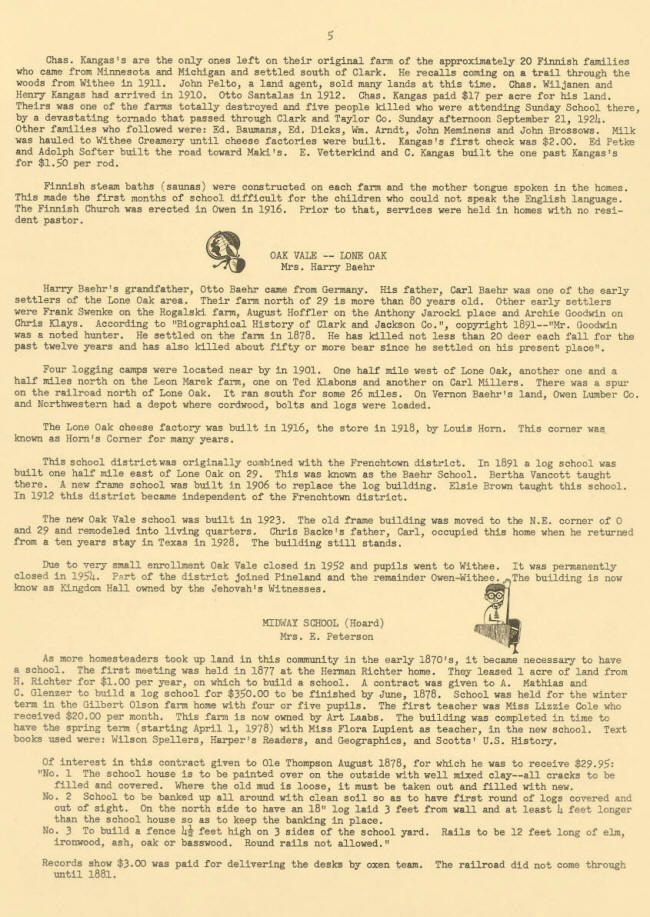|
[Memory
Trails Index]
Transcription
Janet Schwarze
Chas. Kangas ‘s are the
only ones left on their original farm of the approximately 20 Finnish families
who came from Minnesota arid Michigan and settled south of Clark. He recalls
coming on a trail through the woods from Withee in 1911. John Pelto, a land
agent, sold many lands at this time. Chas. Wiljanen and Henry Kangas had arrived
in 1910. Otto Santalas in 1912. Chas. Kangas paid $17 per acre for his land.
Theirs was one of the farms totally destroyed and five people killed who were
attending Sunday School there, by a devastating tornado that passed through
Clark and Taylor Co. Sunday afternoon September 21, l924. Other families who
followed were: Ed. Baumans, Ed. Dicks, Wm. Arridt, John Meminens and John
Brossows. Milk was hauled to Withee Creamery until cheese factories were built.
Kangas’s first check was $2.00. Ed Petke and Adolph Softer built the road toward
Maki’s. E. Vetterkind and C. Kangas built the one past Kangas’s for $1.50 per
rod.
Finnish steam baths (saunas) were constructed on each farm and the mother tongue
spoken in the homes. This made the first months of school difficult for the
children who could not speak the English language. The Finnish Church was
erected in Owen in 1916. Prior to that, ser-ices were held in homes with no
resident pastor.
OAK VALE -- LONE OAK
Mrs. Harry Baehr
Harry Baehr’s grandfather, Otto Baehr came from Germany. His father, Carl Baehr
was one of the early settlers of the Lone Oak area. Their farm north of 29 is
more than 80 years old. Other early settlers were Frank Swenke on the Rogalski
farm, August Hoffler on the Anthony Jarocki place and Archie Goodwin on Chris
Klays. According to “Biographical History of Clark and Jackson Co. “, copyright
1891--Mr. Goodwin was a noted hunter. He settled on the farm in 1878. He has
killed not less than 20 deer each fall for the past twelve years and has also
killed about fifty or more bear since he settled on his present place”.
Four logging camps were located near by in 1901. One half mile west of Lone Oak,
another one and a half miles north on the Leon Marek farm, one on Ted Klabons
and another on Carl Millers. There was a spur on the railroad north of Lone Oak.
It ran south for some 26 miles. On Vernon Baehr’s land, Owen Lumber Co. and
Northwestern had a depot where cordwood, bolts and logs were loaded.
The Lone Oak cheese factory was built in 1916, the store in 1918, by Louis Horn.
This corner was known as Horn’s Corner for many years.
This school districtwas originally combined with the Frenchtowri district. In
1891 a log school was built one half mile east of Lone Oak on 29. This was known
as the Baehr School. Bertha Vancott taught there. A new frame school was built
in 1906 to replace the log building. Elsie Brown taught this school. In 1912
this district became independent of the Frenchtown district.
The new Oak Vale school was built in 1923. The old frame building was moved to
the N.E. corner of O and 29 and remodeled into living quarters. Chris Backe’s
father, Carl, occupied this home when he returned from a ten years stay in Texas
in 1928. The building still stands.
Due to very small enrollment Oak Vale closed in 1952 and pupils went to Withee.
It was permanently closed in 19514. Pert of the district Joined Pineland and the
remainder Owen-Withee. The building is now know as Kingdom Hall owned by
the Jehovah’s Witnesses.
MIDWAY SCHOOL (Hoard)
Mrs. E. Peterson
As more homesteaders took up land in this community in the early 1870’s, it
became necessary- to have a school. The first meeting was held in 1877 at the
Herman Richter home. They leased 1 acre of land from H. Richter for $1.00 per
year, on which to build a school. A contract was given to A. Mathias and C.
Glenzer to build a log school for $350.00 to be finished by June, 1878. School
was held for the winter term in the Gilbert Olson farm home with four or five
pupils. The first teacher was Miss Lizzie Cole who received $20.00 per month.
This farm is now owned by Art Laabs. The building was completed in tine to have
the spring term (starting April 1, 1978) with Miss Flora Lupient as teacher, in
the new school. Text books used were: Wilson Speilers, Harper’s Readers, and
Geographics, and Scotts’ U.S. History.
Of interest in this contract given to Ole Thompson August 1878, for which he was
to receive $29.95.
“No. 1 The school house is to be painted over on the outside with well mixed
clay——all cracks to be filled and covered. Where the old mud is loose, it must
be taken out and filled with new.
No. 2 School to be banked up ail around with clean soil so as to have first
round of logs covered and out of sight. On the north side to have an 18” log
laid 3 feet from wail and at least ) feet longer than the school house so as to
keep the banking in place.
No. 3 To build a fence 1 feet high on 3 sides of the school yard. Rails to be 12
feet long of elm, ironwood, ash, oak or basswood. Round rails not allowed.”
Records show $3.00 was paid for delivering the desks by oxen team. The railroad
did not come through until 1881.
[Next]
[Memory
Trails Index]
|
